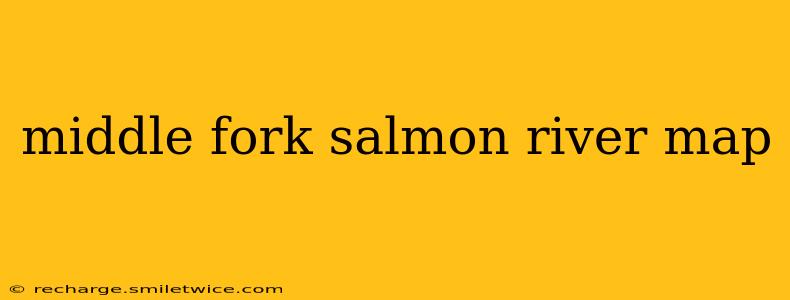The Middle Fork Salmon River, a pristine wilderness area in central Idaho, beckons adventurers with its challenging rapids, stunning scenery, and unparalleled solitude. Planning a trip to this iconic river requires careful preparation, and a good map is your first essential tool. This guide will explore various mapping resources for the Middle Fork Salmon River, helping you plan your own unforgettable journey.
What Makes a Good Middle Fork Salmon River Map?
Before diving into specific map options, let's consider what makes a map ideal for navigating this rugged terrain:
- Detail: The map should clearly show the river's course, including rapids, campsites, access points, and significant landmarks.
- Scale: A scale appropriate for planning a multi-day trip is crucial, allowing you to visualize distances and travel times effectively. Too small, and crucial details are missed. Too large, and the bigger picture is lost.
- Elevation: Understanding elevation changes is vital for planning routes and anticipating challenging sections of the river. Contour lines are essential for this.
- Accessibility: The map should be readily accessible, whether digitally on a GPS device or physically as a paper map.
- Up-to-date Information: River conditions, campsites, and access points can change, so ensure your map reflects the most current information.
Different Types of Middle Fork Salmon River Maps
Several resources provide maps of the Middle Fork Salmon River, each with its strengths and weaknesses:
-
US Forest Service Maps: The official source for information on the Salmon-Challis National Forest, which encompasses the Middle Fork, provides detailed topographic maps. These are generally excellent for planning, highlighting trails, campsites, and other relevant features. They are usually available for purchase online or at ranger stations.
-
National Geographic Topo Maps: These maps offer detailed topographic information, often with a more user-friendly design than some government-issued maps. They're readily available online and in outdoor gear stores.
-
GPS Apps and Devices: Apps like Gaia GPS, Avenza Maps, and AllTrails allow you to download offline maps for use in areas with limited or no cell service. These often incorporate user-generated content, such as campsite reviews and trail conditions. Ensure you download the appropriate map area before you head out. GPS devices are useful for navigation but require careful pre-planning and battery management.
-
River Guides and Trip Planning Books: Many guidebooks specifically focus on the Middle Fork Salmon River and include maps alongside detailed descriptions of rapids, campsites, and potential hazards. These books can provide valuable context and insider knowledge.
Where Can I Find Free Middle Fork Salmon River Maps?
While highly detailed and reliable maps often come at a cost, some free resources can provide a general overview:
-
Online Map Services: Services like Google Maps and MapQuest can offer a basic overview of the area, but the level of detail may not be sufficient for navigating the river's complexities. Use these as a supplementary tool, not a primary navigation resource.
-
The Salmon-Challis National Forest Website: The official website may offer downloadable PDFs of some maps, though these might not be as comprehensive as their commercially available counterparts. Check their website regularly for updates.
H2: What are some key landmarks to look for on a Middle Fork Salmon River map?
Key landmarks to find on your map include major rapids (like Impassable, Mallard, and Cabin Creek), established campsites, river access points (like the Boundary Creek and Corn Creek trailheads), and significant tributaries. Knowing the locations of these features will significantly aid in your navigation and trip planning. Look for prominent features such as mountains, canyons, and geological formations.
H2: How do I choose the right map scale for my Middle Fork Salmon River trip?
The best map scale depends on your trip's length and detail requirements. For a shorter trip, a larger-scale map providing more detail might suffice. For a multi-day journey, a smaller-scale map showing the entire river's course is essential, but you'll likely supplement it with more detailed maps of specific sections.
H2: Are there any online resources that show real-time river conditions for the Middle Fork Salmon River?
While there's no single, universally agreed-upon real-time river condition reporting for the Middle Fork, various sources can give you a good idea. Check recent trip reports on forums frequented by river runners, and contact local outfitters or ranger stations for up-to-date information. River levels and flows are crucial factors to consider before heading out.
Conclusion
Choosing the right Middle Fork Salmon River map is paramount for a safe and enjoyable trip. Combining resources—a detailed topographic map, a GPS device or app, and a comprehensive guidebook—provides the best preparation for tackling this challenging and rewarding river adventure. Remember to always prioritize safety and thoroughly research the conditions before embarking on your journey.
